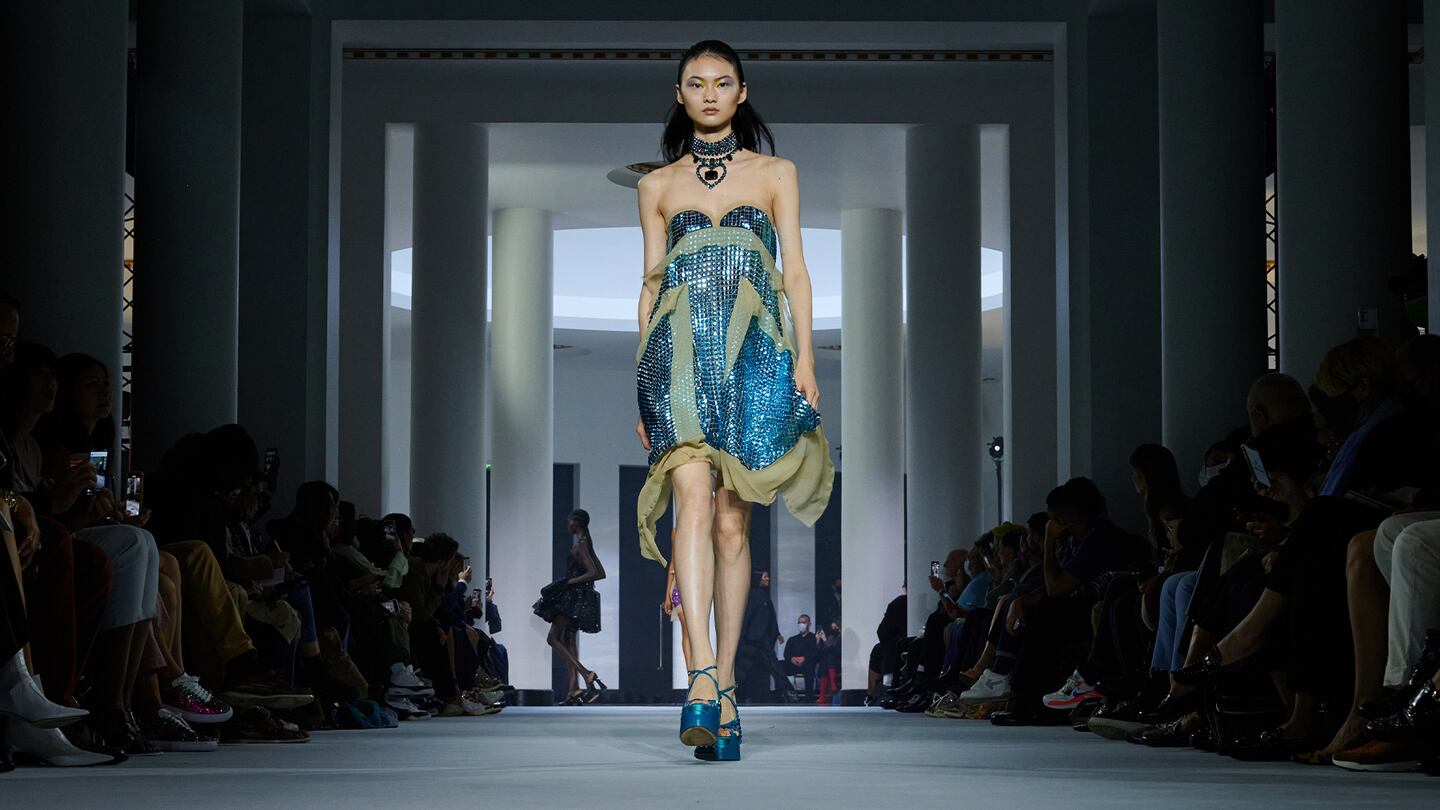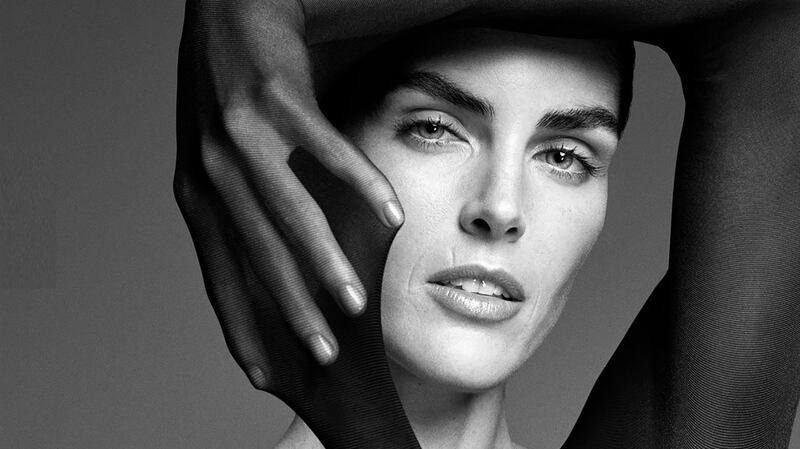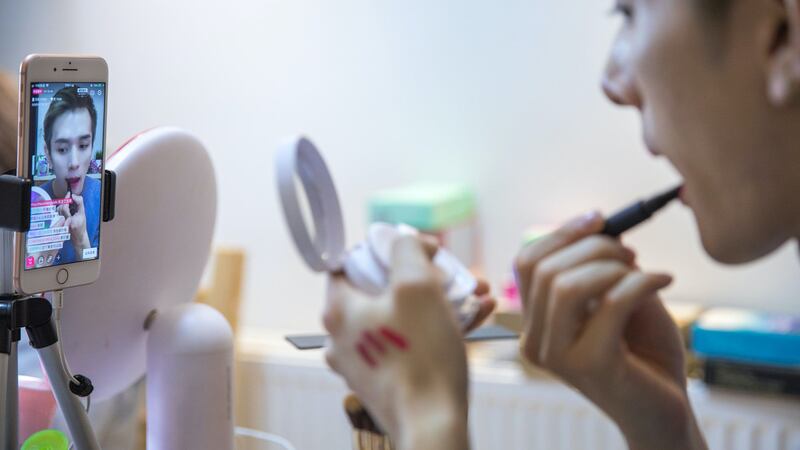
The Business of Fashion
Agenda-setting intelligence, analysis and advice for the global fashion community.

Agenda-setting intelligence, analysis and advice for the global fashion community.

Earlier this month, Fosun Fashion Group changed its name to Lanvin Group, putting the 132-year-old French luxury brand it acquired in 2018, at the centre of its corporate rebrand.
“It’s time to set up our vision to the industry and the world that we [not only want to develop] a portfolio of heritage brands [but also] turn on a new phase of growth [for those brands],” explained Lanvin Group chief executive Joann Cheng at an interview in her office in a gleaming tower high above Shanghai’s famed riverside Bund promenade.
“[When people see the name] Lanvin Group, they immediately know what industry you are in [and] what position you are aiming at for the future,” she added.
Though it may seem like a cosmetic change, the rebrand has clarified the intentions of a firm with a parent company that has many non-fashion assets and deep roots in the pharmaceuticals, real estate and insurance industries.
ADVERTISEMENT
Fosun International, the publicly traded arm of Chinese private investment company Fosun Group, began dabbling in international fashion brands a decade ago as part of a broader strategy targeting categories with high growth potential among China’s middle-class consumers.
Chaired by co-founder Guo Guangchang, a colourful Shanghai-based billionaire often dubbed “China’s Warren Buffet,” Fosun made its first fashion-related foray in 2011, purchasing a small stake in Greek accessories brand Folli Follie.
Fosun Fashion Group, a unit of the firm, then made its big splash in 2018 when it bought a majority stake in storied French brand Lanvin, which had fallen on hard times as multiple creative directors came and went following the sudden departure of Alber Elbaz in 2015.
Other high-end brands in Lanvin Group’s portfolio include Italian footwear label Sergio Rossi, which was acquired in May, US-based St. John Knits, Austrian lingerie maker Wolford and Italian menswear label Caruso. German casualwear brand Tom Tailor was acquired last year.

As well as attracting more attention to the group, the recent rebrand seemed to signal its confidence and, as Cheng points out, a readiness to put its foot on the accelerator for growth across China, the US, Japan and other key markets.
The Professed Advantages of Chinese Ownership
The narrative surrounding Chinese companies investing in foreign luxury brands has often focused on advantages local companies can offer on home turf in what is arguably the luxury industry’s single most important market. This includes companies with grand ambitions like the now deeply troubled Ruyi Group whose chairman Qiu Yafu famously proclaimed an intention to build a Chinese analogue of LVMH by investing in brands like Gieves & Hawkes, Sandro, Maje and Cerruti 1881.
Chinese investors with an interest in foreign fashion and luxury brands — including not only debt-ridden Ruyi, but also Lanvin Group and Icicle Group which is the owner of Carven — have tended to buy brands in distress or in need of significant work to complete a turn around.
ADVERTISEMENT
Though Chinese ownership doesn’t seem to have been a major advantage for brands in the China market so far, that’s not to say it won’t change in the future, says Mario Ortelli, managing partner of luxury advisors Ortelli & Co.
In Lanvin they are taking time and investing a lot of money in reactivating the brand and they are now seeing the initial results.
“There hasn’t been a case of a luxury brand owned by a Chinese company seeing groundbreaking growth in China or elsewhere, but I also would point out that, so far, the Chinese buyers have bought into a troubled situation… it’s too early to tell,” he said, adding that he has recently noted encouraging “green shoots” in Lanvin Group’s turnaround of its flagship brand.
Of the fashion brands that were acquired by the company that rebranded as Lanvin Group, many were, “losing money and, in some cases… on the brink of bankruptcy, so it’s a big job to do this kind of turnaround in luxury. In Lanvin [itself] they are taking time and investing a lot of money in reactivating the brand and they are now seeing the initial results,” Ortelli added.
In a year that has seen Lanvin Group make several strategic moves aimed at building a corporate ecosystem that is able to help bolster heritage brands that have hit hard times, it is easy to spot the China market as a major aim for growth. It is not, however, the only focus.
“At group level the sales from China are only 10 percent; 90 percent comes from outside of China. China has a small base and a big potential to grow,” Cheng said.
“[But] our penetration in the US is also [only] around 20 to 30 percent of group sales, so there’s room to grow [there too] and that’s a focus for me,” she added.
Unpacking the deals that the group made this year offers clues to how else it plans to accelerate growth in 2022 and beyond.
A Busy Year for Acquisitions and Partnerships
ADVERTISEMENT
The Sergio Rossi acquisition and recent corporate rebrand are just the latest in a spate of manoeuvres. The group has also been building out a broader ecosystem to support the brands in its growing portfolio. As an investment company that has only really operated fashion brands since 2018, Cheng realised it would be helpful to bring strategic partners on board to strengthen the group’s operating capabilities.
In April, the group announced a strategic partnership with Baozun, one of China’s top luxury ‘Tmall Partners’ (known locally as TPs, shorthand for companies that boost e-commerce operations for brands in the unique environment of Alibaba’s crowded and highly competitive online marketplace) and Activation Group, a marketing agency known for its strength in events.
These partnerships not only provide an advantage for Lanvin Group brands in the China market, they more specifically offer an advantage in the country’s digital sphere, a space in which many international heritage brands have struggled to make serious progress — including Lanvin and Sergio Rossi.

Baozun could be instrumental in a digital turnaround. During last year’s Singles’ Day sale period, the Hong Kong and Nasdaq dual-listed company helped its brand clients — including luxury players Farfetch, Gucci, Burberry and Coach — reach a reported total order volume of 16.5 billion yuan ($2.55 billion). It is one of only a handful of so-called “six star” service partners, as rated by Alibaba’s Tmall.
Other Lanvin Group partners include K11, a luxury mall chain with properties in Hong Kong, Guangzhou, Shenyang, Shanghai and Wuhan which Cheng says can facilitate physical distribution.
The announcement in early October about the name change to Lanvin Group also included information about a new round of funding coming from new strategic partners, including Japanese trading and textile conglomerate Itochu, which Cheng says will be able to help open up the important Japanese market for Lanvin Group’s brands (its brands currently have a minimal presence in the country, according to Cheng).
With the latest funding round of $150 million pushing Lanvin Group’s valuation to above $1 billion, according to its own estimates, the path forward for this growing group of partners, at least some of whom have now also invested capital into the business, points more than ever towards an eventual IPO for the group.
This aim is “not a secret,” according to Patrice Nordey, a Shanghai-based managing partner at consultancy Fabernovel Asia. “You need an end-game and the end-game is to get listed.”
What Needs to Happen Before a Listing
When asked about the potential for an IPO in its future, a spokesperson for Lanvin Group said the company is keeping “all options open at the moment.”
If, indeed, the end-game is an IPO, Lanvin Group’s recent name change could be a useful step in upping the company’s awareness and beneficial as a shortcut to advertising its links with fashion, luxury and heritage, all areas that could prove appealing to investors, particularly combined with a convincing China growth and digital growth story.
In Cheng’s own appraisal, the group’s success largely hinges on the success of its namesake. The likelihood of a successful turnaround for the Lanvin brand has increased since the 2019 appointment of creative director, Bruno Sialelli. The 32-year-old is widely credited with infusing the French fashion house founded by Jeanne Lanvin in 1889 with a youthful energy and a much needed appeal among younger consumers.
“We’ve seen the designer making a recognisable creative vision for the brand after a bit of uncertainty,” Ortelli said. “For a brand like Lanvin, everything comes from creativity, you can’t just play the heritage card, or play the logo card, you have to have a strong creative vision that taps into the preferences of the high-end consumers and that is translated in products from various price points that can [also] lure the younger generation.”
Interestingly, according to Cheng, Lanvin’s two biggest product successes last year were sneakers — the Bumper and Curb models — which helped the brand achieve a “three-digit growth rate for the last 12 months.”
But creativity is notoriously hard to manage, and commercially successful creativity is unpredictable. These are not the only aspects of luxury fashion that make it a particularly difficult business to crack; it also presents unique challenges across merchandising, marketing, supply chains and retailing.
It’s crucial that Lanvin has a clear strategy to drive some heat that puts the brand back into the conversation.
Even if Lanvin Group does well across all these functions, its brands are still in competition with major players such as Louis Vuitton, Dior and Hermès, which are backed by established powerhouse groups with deep pockets. The bigger brand names have also typically increased their market share since the onset of the pandemic.
“It’s crucial that Lanvin has a clear strategy to drive some heat that puts the brand back into the conversation. It is really important that the brand is not completely left behind, given how aggressive their competition is,” said Angelito Perez Tan, founder and chief executive of RTG Consulting.
But so far, the group seems to be prioritising other areas of business over marketing heat. Nordey posits that what it is actually trying to achieve is rather different to traditional European luxury conglomerates, such as LVMH and Kering — something more akin to the brand accelerators that have found a great deal of success growing international beauty brands in the China market.
Accelerators such as Ushopal or SuperOrdinary use venture capital investment to partner with niche brands, often by directly investing in them, bringing the brand into a ready-made infrastructure that can help boost e-commerce, KOL (local parlance for ‘influencer’) engagement, physical retail, warehousing and logistical capabilities in the China market. Affiliation with these brand accelerators has helped beauty brands from Chantecaille and Juliette Has a Gun to Drunk Elephant and The Ordinary grow much faster in China than they could have without the brand accelerator ecosystem.
In many ways, it’s a model that remains untested for luxury fashion, with that sector’s importance of creativity and heritage weighing more heavily on consumers’ purchasing decisions.
“In the VC game, it’s a race against time; you have to go fast. Luxury is just the opposite, they might make Lanvin into a great brand again but that will take time for sure,” Nordey said, though he adds that he isn’t discounting the ability of Lanvin Group to successfully go public in the not-too-distant future.
When it comes to the prospect of a public offering, what Lanvin Group has to demonstrate to potential investors isn’t necessarily a completed turnaround of Lanvin, an overwhelmingly revitalisation of Sergio Rossi’s digital presence or a particular metric of success for any one of its brands. Rather, it needs to build momentum by showing a positive growth story and making good on its promises along the journey. The addition of another attractive brand to its portfolio could also be a positive move.
With new funding contributing to a war chest that could be used to achieve that and a self-described “patient” outlook for its current investments, Joann Cheng certainly doesn’t sound like a woman who is looking for an exit in a hurry.
“We just want to focus on the operational side and deliver a good result to the market; these are very beautiful brands with a long history and beautiful DNA so we need to be patient,” she said. “We are making small steps every day.”
时尚与美容
FASHION & BEAUTY

Announcement of Gucci Ambassador Xiao Zhan Triggers Shopping Spree
Chinese fans have taken to social media platforms over the weekend to post images of Gucci products and receipts for goods they say have been purchased due to the brand’s announcement of actor Xiao Zhan as its new brand ambassador. Gucci made the announcement on Instagram last Friday and the related hashtag on Weibo had been part of 40 million “discussions” on the social media platform at the time of writing. Xiao Zhan joins a cohort of Chinese celebrities among the Italian luxury brand’s ambassador ranks, including Li Yuchun, Ni Ni and Lu Han. (BoF)
Chinese Appetite for Luxury Fuels L’Oréal Sales Growth
L’Oréal on Thursday posted better-than-expected revenue growth for the third quarter, fuelled by continued strong demand for its luxury lines and sustained growth in China. The French group, which owns brands like Lancôme and makes Armani cosmetics, saw its mainland China business continue to post double-digit growth during the quarter, helped by strong demand for hair and skin care products, though sales were tempered by a resurgence of some regional coronavirus curbs. Chief executive Nicolas Hieronimus said the restrictions had mostly impacted in-store sales and that the country’s e-commerce business continued to flourish. “China’s population and its middle classes are increasing and their appetite for beauty is not satisfied,” he said. (Reuters)
科技与创新
TECH & INNOVATION

‘Lipstick Brother’ Li Jiaqi Moves $2 Billion of Merch in Singles’ Day Opening
China’s Li Jiaqi, a top livestreamer widely known as “lipstick brother,” a nickname he earned by trying on makeup products during his livestreams, pre-sold 12 million yuan ($1.9 billion) worth of merchandise, from Shiseido creams to Apple AirPods, on the first day of Alibaba Group’s annual Singles’ Day shopping festival, as the country’s consumers splash out despite an economic slowdown. (Business Standard)
Alibaba Takes on Shein with International Fashion App
Chinese e-commerce giant Alibaba has a launched fast fashion platform, AllyLikes, to target Western consumer markets. Chinese-founded e-tailer Shein, which pumps out thousands of new styles per week at ultra-low prices, has taken the world’s Gen-Z consumers by storm amid a cross-border e-commerce boom, overtaking Amazon as the top shopping app on US app stores in May. Alibaba looks to be aiming to tap into that boom and, with deep networks in China’s fashion supply chain and experience in cross-border logistics, in addition to its technical expertise, it may be better placed to compete with Shein than anyone else. (BoF)
消费与零售
CONSUMER & RETAIL

Uniqlo to Open First ‘Global Flagship’ Store in Beijing
The Uniqlo Beijing Sanlitun ‘global flagship’ store will open Nov. 6. It’s the company’s third global flagship store to open in mainland China and the first in Beijing. “We are very pleased to be offering customers in Beijing with the ever-evolving concept of LifeWear that meets the daily lifestyle needs of people everywhere,” said Tadashi Yanai, Uniqlo founder and chairman and president and chief executive of the Fast Retailing Group. “The new Beijing store is an important step in our vision to become a truly global digital consumer retailing company.” (Press Release)
Chinese Mall Management Giant Files for Hong Kong IPO
Zhuhai Wanda Commercial Management Group, the property servicing arm of Dalian Wanda Group, has filed for a Hong Kong stock exchange listing and, according to Chinese media reports, is seeking to raise between $3 billion and $4 billion. Filing documents posted by the stock exchange don’t mention funding or market valuation targets, but do reveal the company, which manages 380 malls in mainland China, covering a total area of 54.2 million square metres and with an average occupancy rate (from 2018 to 2020) of 98.8 percent, raised about $6 billion in July and August at a valuation of $28 billion. The company also said in its filing that profit in 2020 fell 8.8 percent year-on-year to 1.1 billion yuan ($172 million). (BoF)
政治,经济与社会
POLITICS, ECONOMY, SOCIETY

China Expands Vaccination Drive to Young Children Amid Delta Variant Outbreak
Some Chinese provinces have sent out notifications that children as young as three will be eligible to receive Covid-19 vaccines in China, where 76 percent of the eligible population has been fully vaccinated and authorities are maintaining a zero-tolerance policy toward outbreaks. Chinese-made vaccines Sinovac and Sinopharm had previously been pronounced safe and effective for children from the age of three, but have only been made available to children aged 12 and over to this point. The expansion of China’s vaccination campaign comes as parts of the country’s north announced new restriction to stamp out small outbreaks of the Delta variant. Gansu, a northwestern province heavily dependent on tourism, closed all tourist sites Monday after finding new Covid-19 cases and residents in parts of Inner Mongolia have been ordered to stay indoors because of an outbreak there. The National Health Commission reported 35 new locally transmitted cases had been detected on Monday. (Associated Press)
China Expands Trials of Property Tax in Pursuit of ‘Common Prosperity’
China will expand trials of a property tax on residential and commercial properties in undisclosed locations, according to an announcement from the National People’s Congress, the country’s top legislative body. Property taxes have proven consistently controversial and difficult to implement in China, where 80 percent of household wealth is tied up in the property market, though President Xi Jinping seems determined to try. Xi is said to have privately instructed economic planners in August to forge ahead with developing a property tax, the next step of his broader “common prosperity” reforms, which are intended to redistribute wealth and “regulate excessively high incomes.” (Financial Times)
China Decoded wants to hear from you. Send tips, suggestions, complaints and compliments to our Shanghai-based Asia Correspondent casey.hall@businessoffashion.com.
With consumers tightening their belts in China, the battle between global fast fashion brands and local high street giants has intensified.
Investors are bracing for a steep slowdown in luxury sales when luxury companies report their first quarter results, reflecting lacklustre Chinese demand.
The French beauty giant’s two latest deals are part of a wider M&A push by global players to capture a larger slice of the China market, targeting buzzy high-end brands that offer products with distinctive Chinese elements.
Post-Covid spend by US tourists in Europe has surged past 2019 levels. Chinese travellers, by contrast, have largely favoured domestic and regional destinations like Hong Kong, Singapore and Japan.